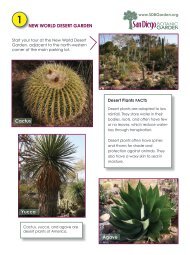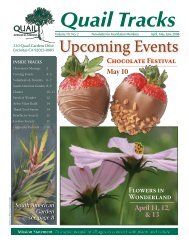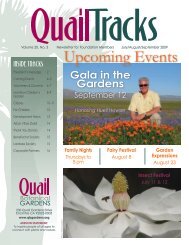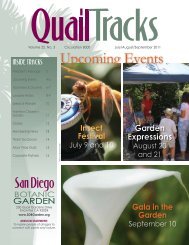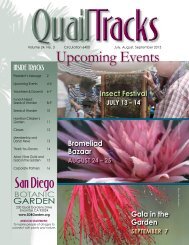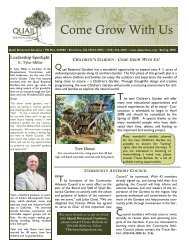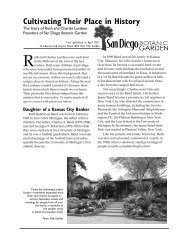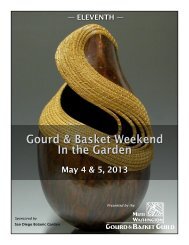Upcoming Events - San Diego Botanic Garden
Upcoming Events - San Diego Botanic Garden
Upcoming Events - San Diego Botanic Garden
You also want an ePaper? Increase the reach of your titles
YUMPU automatically turns print PDFs into web optimized ePapers that Google loves.
Photo: Sally <strong>San</strong>dler<br />
The Bird and Butterfly<br />
<strong>Garden</strong><br />
Last summer the Bird and Butterfly <strong>Garden</strong> was planted at Hamilton<br />
Children’s <strong>Garden</strong>. Since then the plants have really grown and<br />
bloomed. Visit the <strong>Garden</strong> to see a wide variety of colorful plants that<br />
attract our delightful winged wildlife. Read the informative signs about bird<br />
and butterfly gardening. Most residential landscapes already have a mix of<br />
trees, shrubs, groundcovers, and flowering perennials that create good microclimates<br />
for birds and butterflies. It is easy to attract even more to your yard<br />
by adding a few more plants and flowers.<br />
Trees are important in providing perching and nesting for birds. Some of the<br />
trees in our garden include Marina arbutus (Arbutus ‘Marina’), Cape chestnut<br />
(Calodendrum capense), yellow bells (Tecoma stans) and several species of coral<br />
trees (Erythrina). Hummingbirds are especially fond of the abundant nectar<br />
in the long, tubular blooms of coral trees. Bottlebrush trees and shrubs are<br />
hummingbird magnets with their nectar-laden blooms. In the <strong>Garden</strong> see the<br />
shrubby forms ‘Little John’ and ‘Pink Stiletto’ along with weeping bottlebrush<br />
tree (Callistemon viminalis).<br />
For shelter, nesting, and perches plant taller screen shrubs like escallonia and<br />
bottlebrush. Screens and hedges also serve as windbreaks, especially useful for<br />
butterflies, which are generally not strong fliers. Under taller plants add low<br />
plants and groundcovers, which provide cover for butterfly caterpillars that<br />
need a safe place to pupate.<br />
In your garden leave lots of open, sunny sites. Butterflies and birds need open<br />
spaces for flying. Most flowering plants need as much sunlight as possible in<br />
order to bloom well.<br />
The many varieties of butterfly bush (Buddleja davidii and other species and<br />
hybrids) are generally considered the best all-around butterfly flowers. In the<br />
<strong>Garden</strong> there are several butterfly bushes including the striking variegated<br />
Harlequin variety (B. davidii ‘Harlequin’), the grey-leafed, pink-flowering<br />
hybrid ‘Lochninch,’ and the white, winter-flowering Buddleja asiaticum.<br />
In general, butterfly flowers are fragrant. They often have broad surfaces that<br />
form convenient butterfly landing platforms. Examples include daisies and<br />
the flattened flower clusters of yarrow, verbena, and lantana. Some of the best<br />
butterfly flowers in the <strong>Garden</strong> are verbenas, especially Verbena bonariensis,<br />
New Gold lantana, catmint (Nepeta x faasinii), blanket-flower (Gaillardia<br />
hybrids), pelargoniums, and scabiosa.<br />
Try to select plants that have long seasons of bloom or choose a series of<br />
plants that bloom in succession. Star-flower or pentas (Pentas lanceolata) has<br />
a bushy form that is filled with flower clusters that can range in color from<br />
white to pink and red. Pentas blooms throughout the warmer months. Prideof-Madeira<br />
(Echium candicans) is an excellent butterfly shrub in late spring and<br />
early summer. Chaste tree (Vitex agnus-castus) is a summer-blooming shrub<br />
with upright blue flower clusters. In late summer and fall, the yellow flowers<br />
of Copper Canyon marigold (Tagetes lemmonii) are favorites of monarchs and<br />
other butterflies.<br />
For monarch butterflies the best flower of all is tropical milkweed (Asclepias<br />
curassavica). Although all milkweeds are great as both caterpillar food and<br />
butterfly nectar, this species is perhaps the showiest with its exotic orange<br />
blooms. Be sure to plant several plants because the hungry caterpillars can<br />
eat up all the leaves of a single plant. In our <strong>Garden</strong> a curious milkweed is the<br />
swan or balloon plant (Asclepias physocarpa). It is shrubby in size with peculiar,<br />
large, globular seedpods.<br />
8<br />
by Dave Ehrlinger, Director of Horticulture



